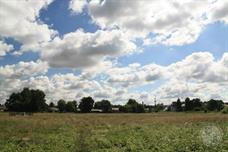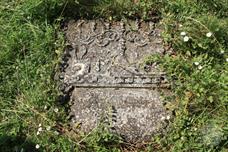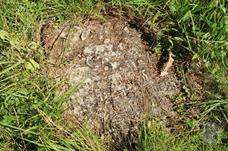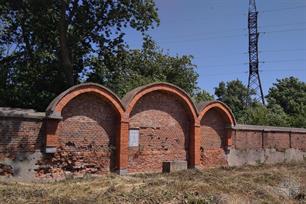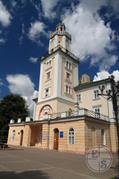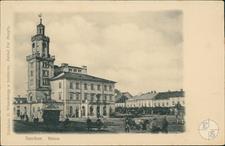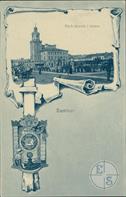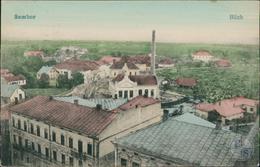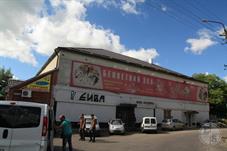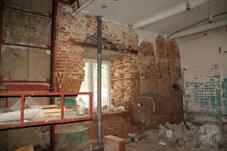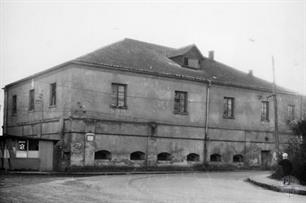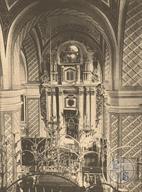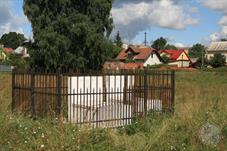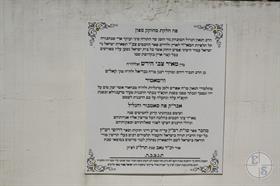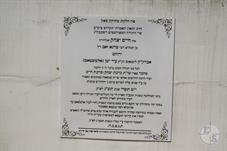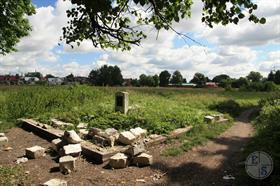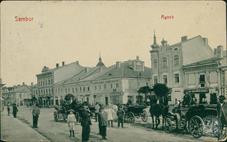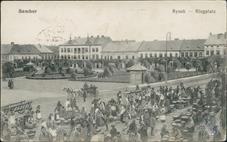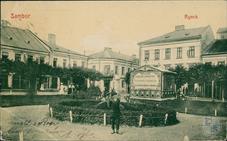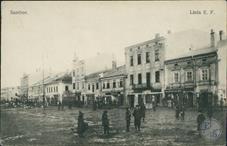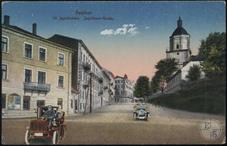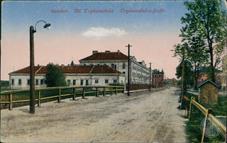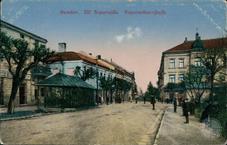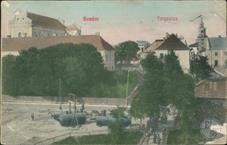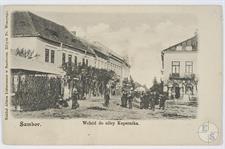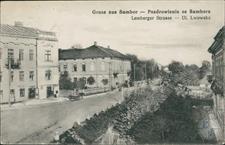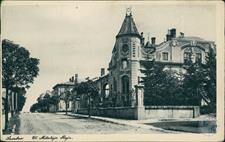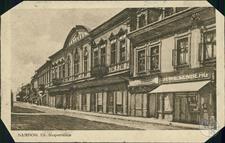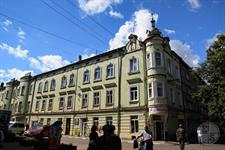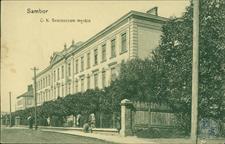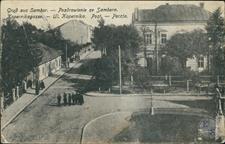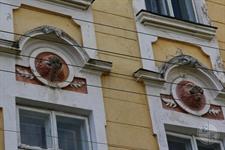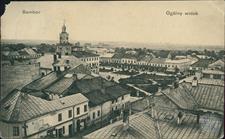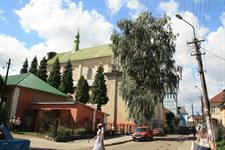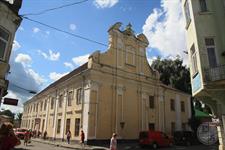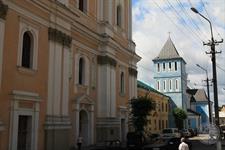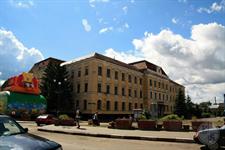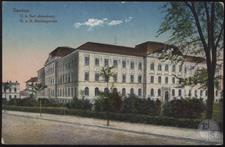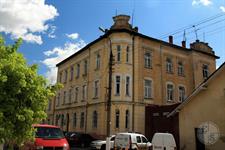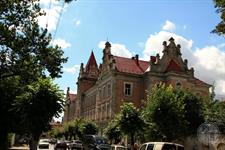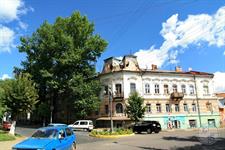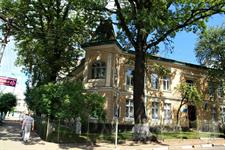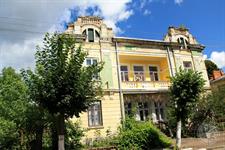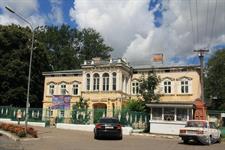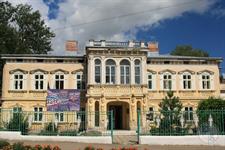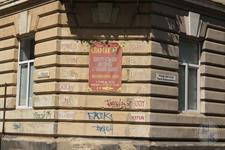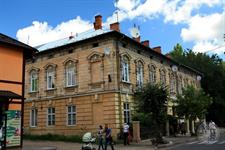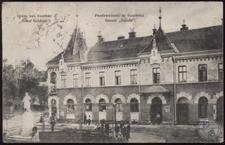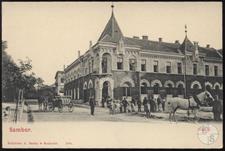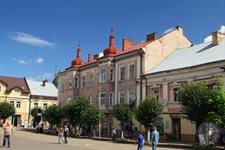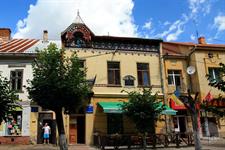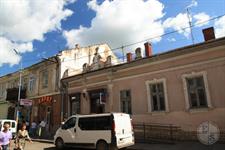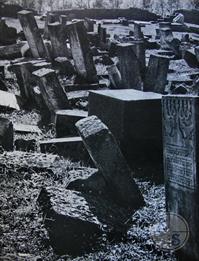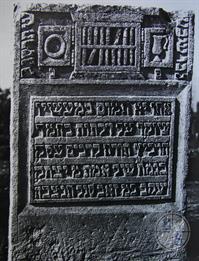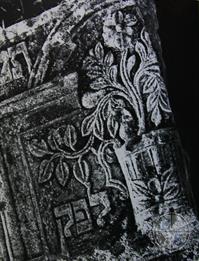Sambir
Sambir district, Lviv region
During the time of the Great Mongolian State, the settlement of Sambir (now the city of Old Sambir), which existed since ancient times, was devastated by the Golden Horde. The surviving residents fled and took refuge in the forest thickets on the banks of the Dniester, in the town of Pogonich, which soon grew and became known as Novy Sambor, and later Sambor. The year of its foundation is considered to be 1241.
In 1390 Sambir received the status of a city and the Magdeburg Law.
In 1604, Grigory Otrepiev, known as False Dmitry I, who pretended to be the son of Tsar Ivan IV the Terrible, settled in the castle of the headman of Sambir, Jerzy Mniszek. Jerzy Mnishek, whose daughter was the wife of False Dmitry I, helps him ascend the Russian Throne on June 21, 1605, which he held until May 17, 1606.
In 1772, after the division of the Commonwealth, the Sambir lands became part of the Kingdom of Galicia and Lodomeria with its capital in Lemberg. Since 1804 - in the Austrian Empire. Emperor Joseph II grants Sambor the title of "Free Royal City".
On September 26, 1939, according to the Non-Aggression Pact between Germany and the Soviet Union, regular units of the Red Army enter the territory of the former Polish Sambir district.
In 1390 Sambir received the status of a city and the Magdeburg Law.
In 1604, Grigory Otrepiev, known as False Dmitry I, who pretended to be the son of Tsar Ivan IV the Terrible, settled in the castle of the headman of Sambir, Jerzy Mniszek. Jerzy Mnishek, whose daughter was the wife of False Dmitry I, helps him ascend the Russian Throne on June 21, 1605, which he held until May 17, 1606.
In 1772, after the division of the Commonwealth, the Sambir lands became part of the Kingdom of Galicia and Lodomeria with its capital in Lemberg. Since 1804 - in the Austrian Empire. Emperor Joseph II grants Sambor the title of "Free Royal City".
On September 26, 1939, according to the Non-Aggression Pact between Germany and the Soviet Union, regular units of the Red Army enter the territory of the former Polish Sambir district.
The first mention of the Jews of Sambir dates back to 1447. In 1542, King Sigismund the Old Jews were forbidden to live in Sambir.
In 1551, the ban was confirmed by Queen Bona, but Jews continued to settle in the suburbs of the city. Thus, a separate Jewish district was formed, which received the name "Blich".
In 1551, the ban was confirmed by Queen Bona, but Jews continued to settle in the suburbs of the city. Thus, a separate Jewish district was formed, which received the name "Blich".
In the 16th century many Jews rented flour mills and bakeries. In the 17th century there were synagogues and a Jewish cemetery in Sambir.
In the middle of the 17th century. the relations of the townspeople towards the Jews became especially aggravated; referring to the new decree of Jan Casimir, they did not let the Jews into the city and petitioned for their complete expulsion from Blich.
Kagal then borrowed 8,000 zlotys in order to secure patronage. The guarantor for the loan was the Przemysl kahal, whose prikagal was Sambor. When, after two years, the kahal of Sambir was unable to pay the interest, the creditors turned to the Przemysl kahal.
At a meeting of the crown vaad in Yaroslav (October 13, 1682), an agreement was made, according to which the Przemysl kahal assumed the entire debt, while the Sambir kahal undertook to annually contribute 240 zlotys in his favor: 120 in cash, and the remaining 120 should be collected by Przemysl Jews from merchants who attended fairs in Sambir.
In 1735, King August II gave the Jews a "privilege" for freedom of residence and trade in Sambir, and also allowed them to open a butcher's shop: For your information. Allows them to set up a butcher's shop so that one butcher sells meat. They are subject to castle jurisdiction, as they live on the territory of the castle.
In 1740 the "privilege" was confirmed by King Augustus III.
In 1763 the Jewish community of Sambor was allowed to build a new synagogue.
In 1764, 513 Jews already lived in the town.
At the beginning of the 19th century in Sambor there was a Jewish printing house that specialized in the production of Jewish calendars.
In 1815, 15 Karaites lived in Sambor.
In 1820 a Jew opened a bank in the city.
In 1830, a textile factory for the production of tablecloths was founded by Jews.
In 1880, 4427 Jews lived in Sambir - 33.1% of the total population of the town.
In the middle of the 17th century. the relations of the townspeople towards the Jews became especially aggravated; referring to the new decree of Jan Casimir, they did not let the Jews into the city and petitioned for their complete expulsion from Blich.
Kagal then borrowed 8,000 zlotys in order to secure patronage. The guarantor for the loan was the Przemysl kahal, whose prikagal was Sambor. When, after two years, the kahal of Sambir was unable to pay the interest, the creditors turned to the Przemysl kahal.
At a meeting of the crown vaad in Yaroslav (October 13, 1682), an agreement was made, according to which the Przemysl kahal assumed the entire debt, while the Sambir kahal undertook to annually contribute 240 zlotys in his favor: 120 in cash, and the remaining 120 should be collected by Przemysl Jews from merchants who attended fairs in Sambir.
In 1735, King August II gave the Jews a "privilege" for freedom of residence and trade in Sambir, and also allowed them to open a butcher's shop: For your information. Allows them to set up a butcher's shop so that one butcher sells meat. They are subject to castle jurisdiction, as they live on the territory of the castle.
In 1740 the "privilege" was confirmed by King Augustus III.
In 1763 the Jewish community of Sambor was allowed to build a new synagogue.
In 1764, 513 Jews already lived in the town.
At the beginning of the 19th century in Sambor there was a Jewish printing house that specialized in the production of Jewish calendars.
In 1815, 15 Karaites lived in Sambor.
In 1820 a Jew opened a bank in the city.
In 1830, a textile factory for the production of tablecloths was founded by Jews.
In 1880, 4427 Jews lived in Sambir - 33.1% of the total population of the town.
The first rabbi of Sambir (since 1767) was Yosef Moishe Eisenberg. After the departure of the Yosef in Eretz Yisroel, his son Yitzchok became a rabbi. In 1813–25 Rabbi of Sambir - son of I. Eisenberg Yankel Naftoli.
The next rabbi of Sambir was Yosef Arye Rapoport, then his son Dovid, after D. Rapoport his son Yosef.
In 1825–73 the rabbi in Sambir was Yosef Hirsh Zvi Vitmeir.
In 1878, the Hasidic court in Sambir was founded by Uri Yoles, in 1910 the dynasty was continued by his son Yehuda Zvi, then the dynasty was headed by the son-in-law of the latter, Chaim Yoel Moshkovich (1888–1941, Treblinka).
The next rabbi of Sambir was Yosef Arye Rapoport, then his son Dovid, after D. Rapoport his son Yosef.
In 1825–73 the rabbi in Sambir was Yosef Hirsh Zvi Vitmeir.
In 1878, the Hasidic court in Sambir was founded by Uri Yoles, in 1910 the dynasty was continued by his son Yehuda Zvi, then the dynasty was headed by the son-in-law of the latter, Chaim Yoel Moshkovich (1888–1941, Treblinka).
Since 1891, the only Jewish commercial school in Galicia (since 1931 - a gymnasium) operated in Sambir, enjoying the rights of government educational institutions.
In 1894, the first Zionist organization "Bnei Zion" was founded in Sambir.
At the end of the 19th century opened a Jewish hospital.
In 1900, 4900 Jews lived here - 28.8% of the total population, in 1910 - 5418 Jews (26.7%).
At the end of the 19th - beginning of the 20th centuries. many Jews left Sambir.
In 1884, in the USA, a charitable society "Ershter Samborer Kranken Verein" was organized by the community of Jews from Sambir.
Since 1907, a cheder metukan has been operating in the town. In Sambor there was a boarding school for Jewish gymnasium students (there were 150 Jewish students in the gymnasium in 1910), in 1907–12. - a school with teaching in Hebrew "Safa Brura". In 1915, 2 Jewish orphanages were founded.
At the beginning of the 20th century Jews played a significant role in the social life of Sambir; the majority in the city duma in 1910 were Jews; the burgomaster was a Jew, Dr. Shteyerman.
In 1904–27 the rabbi of Sambir was Aron Levin, elected in 1922 to the Polish Sejm.
In 1916, 9 Jews were deported from Sambir to Ternopil.
In 1917, the "Society for Settling in Eretz Yisroel" was founded.
In 1918, a branch of "Ha-Shomer Ha-Tsair" was opened in Sambor, a school teaching in Hebrew and the Talmud Torah was founded.
In the 1920s and 30s. there were branches of various Jewish parties and organizations.
In the 1920s opened a branch of the Jewish Credit Bank.
Since 1926, the school for girls "Beis Yaakov" has been operating.
Since 1932, the rabbi of Sambor has been Eliezer Mayses. Since 1925, the rabbinical court was headed by Naftoli Hertz Bumbach. Both of them died during the occupation of Sambir by the Nazis.
Data for 1931 6275 Jews lived in Sambir, which accounted for a little more than 30% of the total population of the town.
In 1894, the first Zionist organization "Bnei Zion" was founded in Sambir.
At the end of the 19th century opened a Jewish hospital.
In 1900, 4900 Jews lived here - 28.8% of the total population, in 1910 - 5418 Jews (26.7%).
At the end of the 19th - beginning of the 20th centuries. many Jews left Sambir.
In 1884, in the USA, a charitable society "Ershter Samborer Kranken Verein" was organized by the community of Jews from Sambir.
Since 1907, a cheder metukan has been operating in the town. In Sambor there was a boarding school for Jewish gymnasium students (there were 150 Jewish students in the gymnasium in 1910), in 1907–12. - a school with teaching in Hebrew "Safa Brura". In 1915, 2 Jewish orphanages were founded.
At the beginning of the 20th century Jews played a significant role in the social life of Sambir; the majority in the city duma in 1910 were Jews; the burgomaster was a Jew, Dr. Shteyerman.
In 1904–27 the rabbi of Sambir was Aron Levin, elected in 1922 to the Polish Sejm.
In 1916, 9 Jews were deported from Sambir to Ternopil.
In 1917, the "Society for Settling in Eretz Yisroel" was founded.
In 1918, a branch of "Ha-Shomer Ha-Tsair" was opened in Sambor, a school teaching in Hebrew and the Talmud Torah was founded.
In the 1920s and 30s. there were branches of various Jewish parties and organizations.
In the 1920s opened a branch of the Jewish Credit Bank.
Since 1926, the school for girls "Beis Yaakov" has been operating.
Since 1932, the rabbi of Sambor has been Eliezer Mayses. Since 1925, the rabbinical court was headed by Naftoli Hertz Bumbach. Both of them died during the occupation of Sambir by the Nazis.
Data for 1931 6275 Jews lived in Sambir, which accounted for a little more than 30% of the total population of the town.
The German occupation of Sambor began on June 30, 1941. In March 1942, an open ghetto was established in the village. In May, there were around 6,500 Jews in the ghetto because a lot of Jews had managed to flee before the German occupation.
Between August and October 1942, there were four Jewish actions carried out in the village. The first action took place on August 4, 1942.
A selection was organized in the stadium by the German gendarmerie, Ukrainian police and a team of the Security police. 150 Jews were murdered.
On August 6, these Jews were transferred to Lviv. Other Jews were brought to the camp. During this action which lasted three days, 4,000 Jews were shot.
The second action took place on September 25–26, 1942. The Jewish Council selected 300 Jews who were shot in the forest of Ralivka, also called Radlowicze.
On October 17–18 and 22, 1942, a third and then fourth action was perpetrated by the German gendarmerie, Schutzpolizei, and the Ukrainian police. Jews were collected from the jail and from nearby villages.
During the third action, 1,000 Jews were sent to Belzec extermination camp and during the fourth action, 460 Jews were sent to Belzec. During the four actions which were perpetrated from August to October 1942, 5000 Jews were sent from Sambir to Belzec.
The open ghetto became a closed ghetto in December 1942. Several actions took place in the ghetto from February to June 1943. During the first action, on February 13, 1943, 500 Jews were executed in the forest of Ralivka.
On April 14, 1943, a second action was carried out during which 1,200 Jews were selected and 900 were shot in the cemetery.
On May 20–22, 1943, a third ghetto action was carried out and several hundreds of Jews “incapable of working” were shot in the forest of Ralivka.
The liquidation of the ghetto took place on June 5, 1943, and 1,000 Jews were shot in the forest of Ralivka.
Sambir. Market Square, 2014
There were about 160 Jewish survivors, many of them hidden by local farmers, both Poles and Ukrainians.
Catholic monks rescued more than 10 Jewish children in Sambir.
27 Poles and Ukrainians were shot for helping Jews in the city.
After the liberation in August 1944, about 150 Jews returned to Sambir.
In 2005, the city still had a Jewish population.
In 2015, Jews do not live in Sambir.
Between August and October 1942, there were four Jewish actions carried out in the village. The first action took place on August 4, 1942.
A selection was organized in the stadium by the German gendarmerie, Ukrainian police and a team of the Security police. 150 Jews were murdered.
On August 6, these Jews were transferred to Lviv. Other Jews were brought to the camp. During this action which lasted three days, 4,000 Jews were shot.
The second action took place on September 25–26, 1942. The Jewish Council selected 300 Jews who were shot in the forest of Ralivka, also called Radlowicze.
On October 17–18 and 22, 1942, a third and then fourth action was perpetrated by the German gendarmerie, Schutzpolizei, and the Ukrainian police. Jews were collected from the jail and from nearby villages.
During the third action, 1,000 Jews were sent to Belzec extermination camp and during the fourth action, 460 Jews were sent to Belzec. During the four actions which were perpetrated from August to October 1942, 5000 Jews were sent from Sambir to Belzec.
The open ghetto became a closed ghetto in December 1942. Several actions took place in the ghetto from February to June 1943. During the first action, on February 13, 1943, 500 Jews were executed in the forest of Ralivka.
On April 14, 1943, a second action was carried out during which 1,200 Jews were selected and 900 were shot in the cemetery.
On May 20–22, 1943, a third ghetto action was carried out and several hundreds of Jews “incapable of working” were shot in the forest of Ralivka.
The liquidation of the ghetto took place on June 5, 1943, and 1,000 Jews were shot in the forest of Ralivka.
Sambir. Market Square, 2014
There were about 160 Jewish survivors, many of them hidden by local farmers, both Poles and Ukrainians.
Catholic monks rescued more than 10 Jewish children in Sambir.
27 Poles and Ukrainians were shot for helping Jews in the city.
After the liberation in August 1944, about 150 Jews returned to Sambir.
In 2005, the city still had a Jewish population.
In 2015, Jews do not live in Sambir.
Quite a lot of old buildings of Austrian and Polish times have been preserved in the city, incl. some very interesting architectural monuments.
Sources:
- Jewish encyclopedia of Brockhaus & Efron
- Russian Jewish encyclopedia
- Goberman D. Jewish tombstones in Ukraine and Moldova. St. Petersburg, 2001
Photo:
- Eugene Shnaider
- David Goberman
- Jewish Cemeteries Initiative. Sambir New Jewish Cemetery
- Center for Jewish art. Sambir (Sambor)
- Biblioteka Narodowa Polona. Sambor
- Jewish encyclopedia of Brockhaus & Efron
- Russian Jewish encyclopedia
- Goberman D. Jewish tombstones in Ukraine and Moldova. St. Petersburg, 2001
Photo:
- Eugene Shnaider
- David Goberman
- Jewish Cemeteries Initiative. Sambir New Jewish Cemetery
- Center for Jewish art. Sambir (Sambor)
- Biblioteka Narodowa Polona. Sambor

- Home
- Shtetls
- Vinnytsia region
- Volyn region
- Dnipro region
- Donetsk region
- Zhytomyr region
- Zakarpattia region
- Zaporizhzhia region
- Ivano-Frankivsk region
- Kyiv region
- Kropyvnytskyi region
- Luhansk region
- Lviv region
- Mykolayiv region
- Odessa region
- Poltava region
- Rivne region
- Sumy region
- Ternopil region
- Kharkiv region
- Kherson region
- Khmelnytskyi region
- Chernihiv region
- Chernivtsi region
- Cherkasy region
- Crimea
- Synagogues
- Cemeteries
- Objects & guides
- Old photos
- History
- Contact
Jewish towns of Ukraine
Jewish towns of Ukraine
My shtetl
My shtetl
Donate
